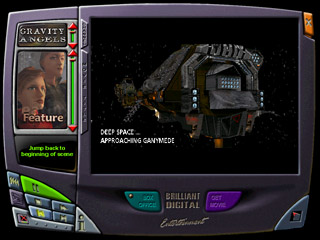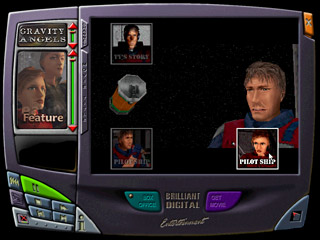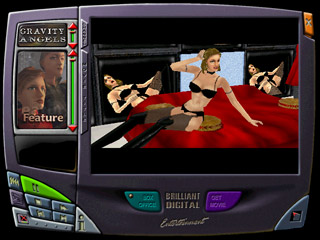Today’s “game” is a member of that much-reviled (by me) genre of video game, the interactive movie. This atrocity of game genres was spawned directly from the widespread availability of CD-ROM hardware and the vast quantities of space afforded to games. And what’s the first thing enterprising would-be game developers thought to do with this space? Hook a video camera up to a computer, record people (not necessarily trained actors, mostly people who worked in the office), and glue together film snippets with some code that allows the user to choose path A or path B at various junctures. Indeed, the interactive movie is also the type of game I most love to hate. Even though they’re horrible games, interactive movies often provide ample opportunity to study new multimedia formats, so-called full motion video or FMV data formats, which is my hobby pursuit and the main reason that I have so many games stockpiled in the first place.

Today’s game is called Gravity Angels Part 1: Alien Discovery from Brilliant Digital Entertainment (BDE). The title is a mouthful and it’s also ambitious. The “Part 1” implies that there will be many parts, but I’m not so confident (see also Seanbaby’s dissertation regarding the misnaming of Rapjam Volume 1). This game has “Multipath Movies” plastered all over it, including a link to www.multipathmovies.com, now defunct. Installing the game actually installs a program called the BDE Projector (BDE is Brilliant Digital Entertainment) which is shown above. Then it plays an intro by a singing, dancing, tuxedo-clad frog explaining how to use the Projector; I’m surprised the WB Network didn’t unleash legal hellfire upon them.
The Projector launches a .doc file containing instructions and a general overview of the Multipath Movies (MPMs). This document is the first clue that I have that something might be amiss. It keeps talking about how the Projector is used for previewing MPM content and then the player can choose to buy the movie from the website at which point it will be automatically streamed to the user’s computer. I was under the impression that this disc contained a full MPM. It comes with previews of various other MPM titles. And thankfully, it does come with the full content of Gravity Angels Part 1 on the CD-ROM. Phew. For a second there, I thought I got cheated out of… the absolutely negligible amount I paid for this CD ($34 / 50 CDs = how many pennies per CD?).
According to the previews, there are, in fact 3 more parts to Gravity Angels. So they weren’t just being hopeful.
I really don’t think I can spend too much time on the actual game itself. There’s not much to talk about. It’s an interactive movie. Every so often, there are squares on the screen prompting the user to make a path selection. You don’t really have to interact at these junctures as the game will seamlessly pick one (not sure how it chooses) and keep right on going without ever missing a beat. To go much further with any kind of review would be akin to reviewing a movie, which I’m just not qualified to do.

The Projecter allows you to fast forward which speeds up the animation and the sound, though there is no analogous rewind. Chapter skips, both forwards and backwards are supported, however.
The part about this whole affair that impresses me is that all of the animation does appear to be real-time 3D when I was fully expecting pre-rendered FMV. My first indication was that the FAQ section of the documentation explained that S3 and other video cards might have trouble because 3D hardware acceleration is still a young and rapidly growing field. Upon viewing the movie, I decided it’s way too unpolished to be pre-rendered. I have looked all over the CD-ROM copy and Digital Projector program but I cannot find any copyright date. By today’s standards, the 3D animation is absolutely pathetic, but looks reasonable by the standards of, maybe mid-90s 3D games. Googling for Multipath Movies reveals this Word Spy entry that notes the earliest press mention of the tech as October, 1996 (allegedly still in development at the time).
Technically, the interactive movies appear to be comprised of 3 files: a .nav file, a .map file, and a .bhf file. The BHF file is the big one. Presumably, it contains a lot of 3D vector information and how to animate them, along with audio data which, according to BDE’s partners page, is compressed using VoxWare audio compression. The main Gravity Angels BHF file on the CD-ROM is 162 MB large. I tend to think a lot of internet users were still on dialup in the mid-late 90s (or maybe that was just me) and I really don’t see how such a file could have been plausibly delivered online back then.
Now that I am running so much new, untrusted software on my Windows XP system, I am diligently running Spybot Search & Destroy frequently. The first thing the program picked up on today’s run was the BDE Digital Projector. Apparently, it is known to download and display rich 3D media advertisements on the desktop. Brilliant Digital appears to be no more as the last press release from their site is dated over 2 years ago. The spyware allegation makes this press release all the more interesting: BRILLIANT DIGITAL ENTERTAINMENT ANNOUNCES ONE BILLION RICH-MEDIA ADS SERVED, RELEASES NEW PLAYER VERSION.
I can’t help thinking that maybe BDE would have been better off in the long-term if they had focused on this type of content:
